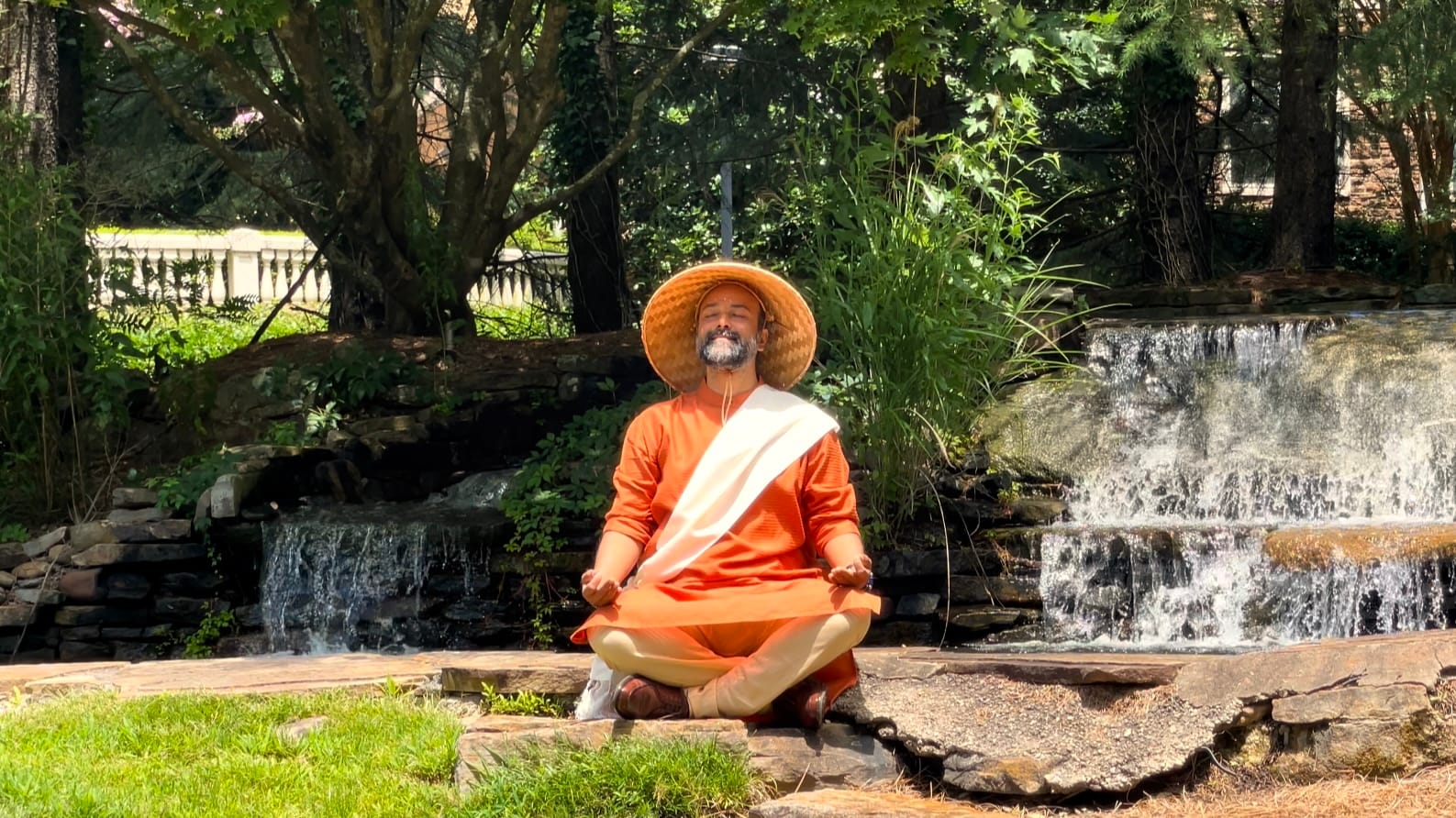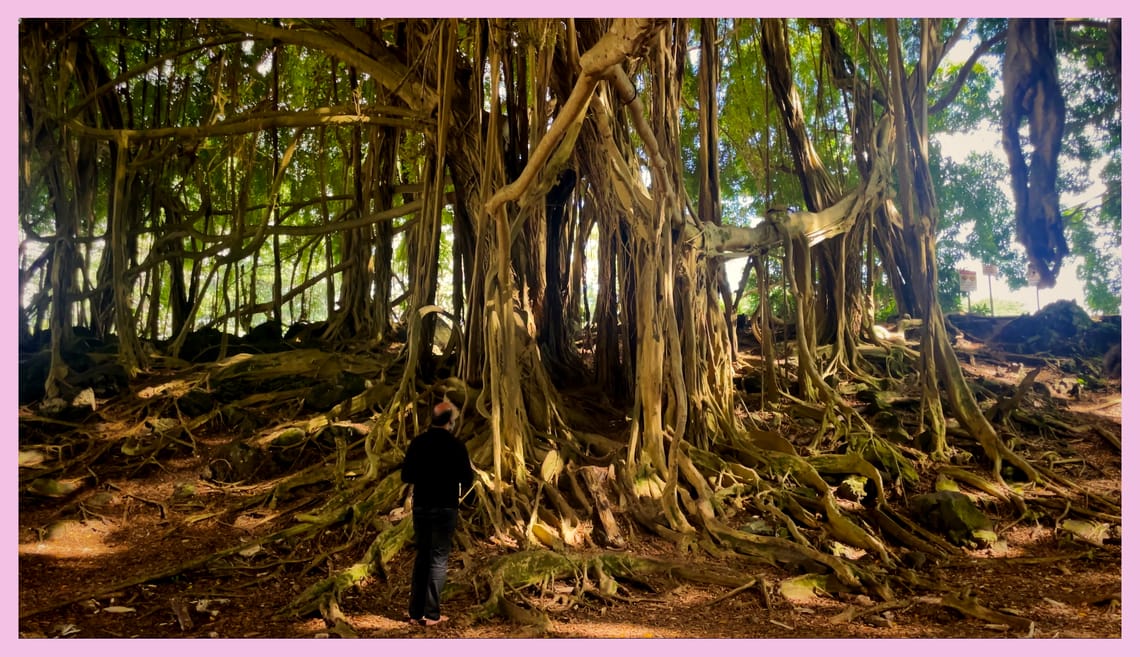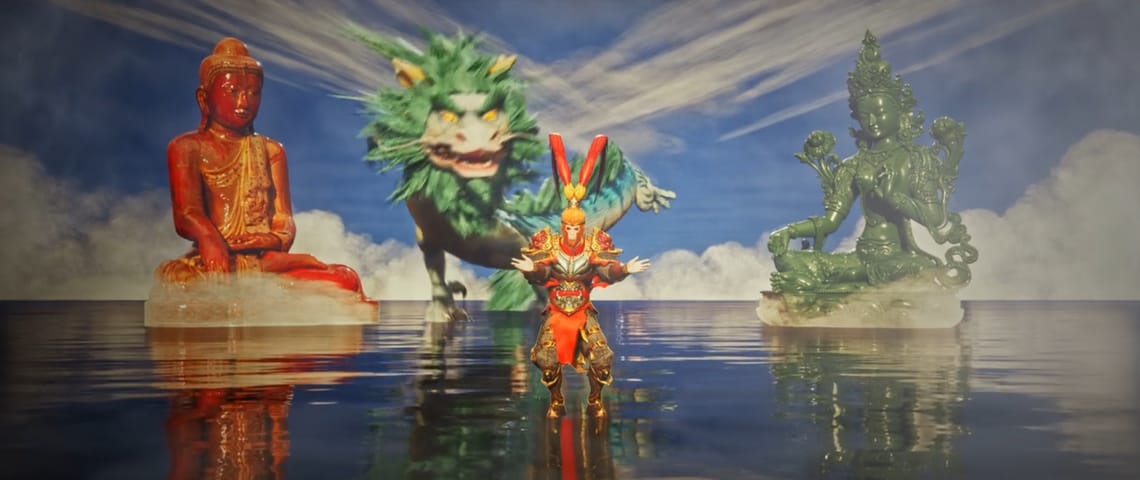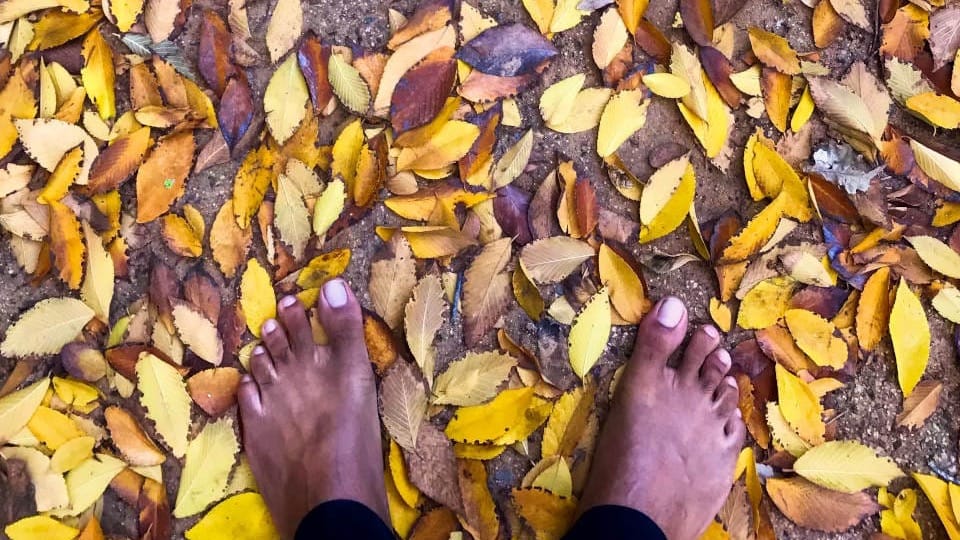Our Yoga practice is rooted in the Eight Limbs of Yoga, also known as, ashtanga. In Sanskrit, ashtanga, translates to ‘eight limbs’. The Eight Limbs of Yoga were transmitted by Great Sage Patanjali and recorded as a set of 196 brief statements, or aphorisms, known as sutras in Sanskrit. Collectively, these are commonly known and published widely as, The Yoga Sutras. The exact date of initial transmission and recording of the sutras varies, though according to renowned yoga teacher, B. K. S. Iyengar, The Yoga Sutras were shared with the world around 200 BCE[1].
While yoga is often associated with physical postures, breathing exercises and meditation, the eight limbs cover a comprehensive set of personal and social guidelines that are simultaneously specific enough and open enough to fit the journey of spiritual seekers today as well as more than 2,000 years ago. The way this set of eight limbs weaves together the mental, emotional, physical and metaphysical, a.k.a. spiritual, to empower us to transcend all challenges and limitations is an invaluable gift. We feel blessed to have received these eight limbs in this life and are grateful to all our teachers and fellow yoga practitioners for continuing to study, practice and share yoga through the eight limbs.
This article is a space for us to share our perspective on the Eight Limbs of Yoga, particularly the fascinating aspect of self-evolution: how is it that this set of 196 sutras shared thousands of years ago continues to hold fast today while its prescribed practices inspire transcendent insights, both perceptible and imperceptible, that foster the conditions within one’s body, mind, emotions, spirit and soul to feel at peace, experience love, enjoy bliss and create new ways of being? This form of peacefully transforming and evolving oneself through relatively simple ways of working with one‘s energies, without the need of an intermediary, is phenomenally liberating and much needed given the challenges we individually and collectively face today to creatively move toward a peaceful, loving, joyful, balanced world.
Our Entanglement
The Eight Limbs entered our life relatively late in our yoga journey. As first generation Indian kids growing up in a Hindu household in mid-Michigan with our non-English-speaking grandparents living with us, we were steeped in a home life informed by yoga, though it was rarely directly seen. Not until high school, when we experienced the emotional rollercoaster of puberty and determining what we wanted to do with our life, did we turn to our Mother for advice that prompted her to share her yoga practice. This is how personal yoga was to her and happens to be for many practitioners. The Eight Limbs of Yoga are at once a way to establish a personal connection with our intimate conceptions of the Divine as well as a practical set of tools and exercises that increase our ability to live at our highest and best. We had turned to her for advice many times before and her responses were rather practical. Sometimes we agreed, sometimes we went in the complete opposite direction. Nonetheless, it was rare that she delved into her personal spiritual practices. We had been living under the same roof for 16-odd years, shared in various religious ceremonies as a family and yet had no idea she was doing regular yoga practices every day.
As it turned out, there was a set of asanas and breathing practices she claimed to have been doing every morning for years, ever since she was in India, long before we were born. When she showed us these practices, we unwittingly and disrespectfully laughed. They simply looked funny to us, being uninitiated kids growing up in America in the ’90s at a time when yoga was not nearly as popular and widespread in the west as it is now. Outside of a few uncles in the neighborhood showing us a variety of yoga practices and doing regular meditations with our step-father, Self Realization Fellowship and local Hindu temple communities, we were not very familiar with specific yoga practices at that age. The practices were variations on what we later learned as kappalbatti (skull-shining) breath and urdhva hastasana (upward salute). Interestingly, no one in any of the thousands of yoga classes we’ve attended or hundreds of yoga books we’ve read has ever repeated the exact practices our Mom shared with us that day. One person, unique practice. Perhaps related to the community within which she learned or something she arrived at herself. This is an aspect of yoga’s self-evolving nature we find fascinating. While there is a relatively concise set of just under 200 lines of instruction in The Yoga Sutras, the diversity in interpretation and forms of yoga across the globe is vast.
Our Connection
In our yoga journey, we have seen that regular, consistent practice results in the practice itself suggesting modifications to reach higher ground. The source of this inspiration and insight is none other than our Self. We are intentionally creating sacred space to listen not only to our physical body, but also our mental, emotional, spiritual and soul bodies. Creating this space and then gently holding an open, receptive, loving posture to tune into what we sense in response allows for these beautiful transcendent insights to reach us. They invite us to greater awareness, creativity and the evolution of our practice to expand and grow in ways that directly respond to the unique union of our being and the universe in its current state. In the language of yoga and the sutras, through the practices, we are entering realms of higher consciousness beyond thought, beyond reason, that contain the essence of existence, life, bliss and truth, always returning with treasures we could not have imagined beforehand.
After years of practicing and studying many styles of yoga with different teachers and studios in cities spanning India and across the states, we finally arrived at getting a copy of Patanjali’s Yoga Sutras to read around 2017. Our study of yoga up until that point had been directly through our teachers, communities of practice, books that may have referenced the sutras or intuitively from our family and cultural heritage. Patanjali’s Yoga Sutras provided a framework, breadth and depth of understanding around yoga that at once made it easier to understand as well as increased the mystical potency and power of the practices. There is talk of completely stilling the mind to a state of utter emptiness and bliss. There is talk of the relationships between our mind, heart, soul and body. And, everyone’s favorite, there is talk of supernatural powers. While reading about and even considering pursuing the supernatural powers mentioned, we realized through practice that the powers are only waypoints along the path to deeper states of peaceful meditation and blissfulness far greater than what we may get hung up on attaining through supernatural powers. While the ideal, perfect expectations are set of the most devout, pure and disciplined practitioners, there is compassion in this text inviting newcomers as well as seasoned not-so-perfect practitioners to enjoy in the benefits of these deeper states of peaceful meditation, blissfulness and transcendence. These incredible gifts serve our practice as an inclusive, multi-faith, trauma-informed, body-positive space to cultivate decolonial praxis unleashing our creative energies to build a peaceful, loving, joyful, balanced and grateful world where all beings are happy, healthy and harming none.
Our Offering
It is our deep wish and intention to support you in your practice and enjoy these deep states of meditation, blissfulness and transcendence together.
Following is a brief overview of the Eight Limbs of Yoga.
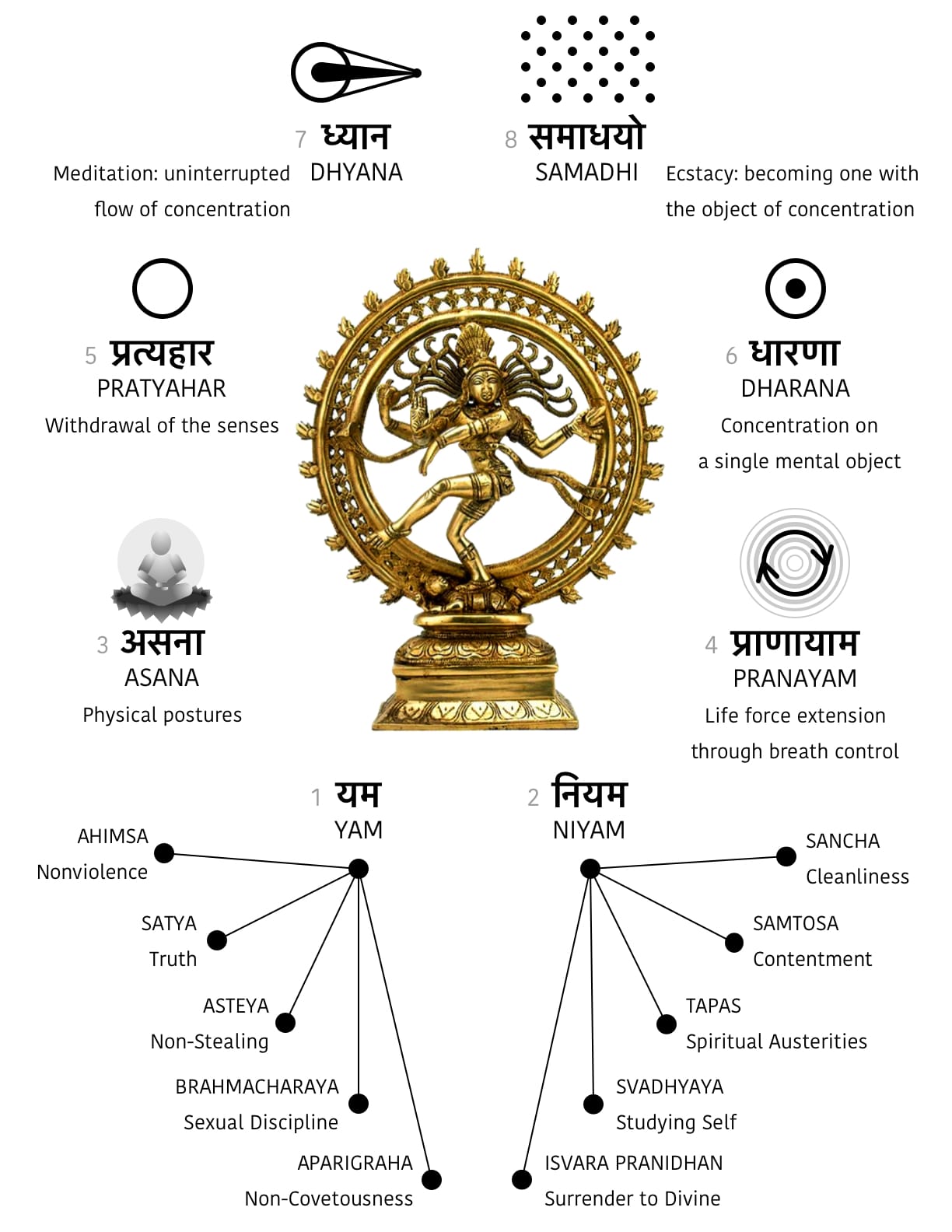
यम • YAM
A limb presenting five philosophical and moral guidelines for how we are in relationship with people and all beings of the planet, including the five elements.
ahimsa: nonviolence. Stated positively, ahimsa is taking good care of ourselves and all beings for peace within and around us.
satya: truthfulness. Determining the truth, staying connected with our personal truths and being honest are all included here.
asteya: non-stealing. Being generous with our time, energy and resources so that we feel no need to take items that belong to others or items that we simply do not need.
brahmacharaya: this can mean celibacy in the case of monks or understanding and embracing our sensual and sexual energies in a disciplined way for non-monastic people.
aparigraha: non-covetousness, non-hoarding. Aligned with the saying, “all that is happening is happening for our highest and greatest good,” aparigraha keeps us in a state of understanding and empowering ourselves so we see that all we need, we have. This brings a sense of contentedness and purpose that safeguards us from becoming enamored with what others have to the point of coveting things we do not need and that do not belong to us. From this place of contentedness and purpose, all that we need and want comes to us at the ideal time (divine timing).
नियम • NIYAM
The compliment to the YAM limb, this is another philosophical and moral set of five guidelines for how we are in relationship with our Self to ensure Self-discipline and spiritual observance that keep us healthy, happy and take us to higher ground.
sancha: cleanliness. Keeping ourselves clean in all our bodies: physical, mental, emotional, spiritual and soul.
samtosa: contentment. Staying in a state of gratitude and contentment regardless of what may be happening in our lives. The same saying from aparigraha from above applies here: “all that is happening is happening for our greatest and highest good.”
tapas: heat; spiritual austerities. The heat generated from spiritual practices such as yoga, meditation, pranayama, fasting and other observances.
svadhyaya: study of sacred scriptures and one's Self.
isvara pranidhan: surrender to the Divine. Seeing we are all connected, all related and all interdependent within a broader Divine container.
असना • ASANA
Posture, pose. Our physical body is the temple for our spirit, our soul, our thoughts and emotions. Taking good care of our bodies is essential for us to progress spiritually. Practicing asanas empowers us to develop the habit of discipline, the ability to concentrate and increase our awareness of what our bodies need to feel at ease, strong, flexible and capable of handling anything that comes our way.
प्राणायाम • PRANAYAM
Life force extension through breath control. This one word, prana, is translated as three concepts in English: ‘life force’, ’breath’ and ‘energy’. Indeed, these three are all tied together. As we practice to gain mastery over our breathing and respiratory processes, we are able to gain more energy and handle more life force all through more prana. We are able to observe the connection between our breath, our thoughts and our emotions.
प्रत्यहार • PRATYAHAR
Withdrawal or Sensory Transcendence. An initial step for meditation, withdrawal of the senses directs our attention and awareness inward. This process helps observe our senses, desires and cravings so we may gently rein them in as and when we want for the benefit of our health and realizing intentions in a good way.
धारणा • DHARANA
Concentration. A second step for meditation, dharana or concentration, is the process of learning how to slow down the thinking process by concentrating on a single mental object. Usually this is an energetic center in the body (i.e. the chakras), an image of a deity or a silent repetition of a sound (mantra).
ध्यान • DHYANA
Meditation/Contemplation. The third step of meditation, is maintaining an uninterrupted flow of concentration on the single mental object we chose in the dharana limb.
समाधयो • SAMADHI
Ecstasy. The transcendental final stage of meditation when we merge with the focal point of our meditation. We come to realize a profound connection to the Divine, an interconnectedness with all beings. With this realization comes the "peace that passeth all understanding" – the experience of bliss and being at one with the universe. This ultimate state can neither be bought nor possessed. It can only be experienced, the price of which is the continual devotion of the aspirant.
ॐ शांति प्यार • Aum Shanti Pyar • Divine Peace Love
[1] B. K. S. Iyengar, Light on Yoga (New York: Schocken Books, 1979), 13.

